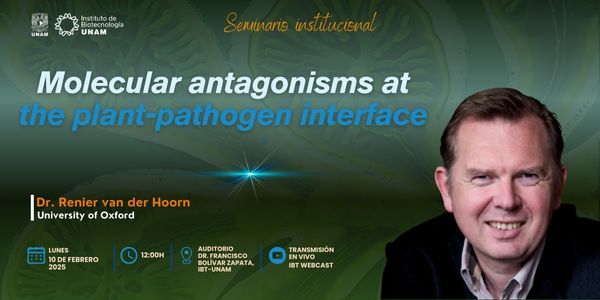
10Feb - 2025
Molecular antagonisms at the plant-pathogen interface
12:00 PM - 02:00 PM|Dr. Renier van der Hoorn|University of Oxford|Invitado por: Dra. Claudia Martínez Anaya
Seminario
Plants are able to recognise bacterial pathogens through conserved fragments of flagellin (flg22) that bind the cell surface receptor FLS2 in most flowering plants. We previously discovered that a plant-secreted beta-galactosidase (BGAL1) promotes flagellin detection by removing the terminal glycan from glycosylated flagellin polymers, presumably promoting flagellin monomerisation. Here, I will discuss the roles of plant-secreted subtilases in the further release of flg22 from the monomeric flagellin precursor. Unexpectedly, we discovered that inactivation of the flg22 epitope by the same subtilases is a dominant, conserved process that might be a logic consequence of bacteria avoiding recognition by producing epitopes that are inactivated by host-secreted proteases. I will also discuss the identity of a BGAL1 inhibitor secreted by the bacterial model pathogen Pseudomonas syringae pv. tomato DC3000 (PtoDC3000). BGAL1 inhibitor 'glycosyrin' is a novel iminosugar produced by a biosynthesis cluster in PtoDC3000 that is regulated by virulence regulator hrpL and occurs in various P. syringae pathovars isolated from diverse plants. We resolved the glycosyrin biosynthesis, regulation and structure and discovered that it not only suppresses flg22 recognition but also dramatically alters the glycobiology of the host plant.
Short bio: Renier van der Hoorn studied chemistry at Leiden University, focused on plant molecular biology and biochemistry. He completed his PhD in 2001 in Molecular Phytopathology at Wageningen University, the Netherlands with Prof. Dr. Pierre de Wit, where he worked on the tomato Cf resistance proteins. He secured a Veni grant from the Dutch Research Council and started his own research by introducing activity-based protein profiling (ABPP) in plants, which he established as visiting scientist to the Sainsbury Laboratory in Norwich, UK. He initiated his own laboratory in 2005 at the Max Planck Institute of Cologne as part of the Chemical Genomics Centre of the Max Planck Society. He secured an ERC Consolidator grant and moved to Oxford University in 2013 as Associate Professor and Tutor in Plant Sciences at Somerville College. He became full professor in 2017 and RS4 Research Professor in 2022, when he secured an ERC Advanced grant. His research focusses on improving transient protein expression in plants and using chemical proteomics and structural modeling to uncover extracellular host manipulation mechanisms employed by microbes when colonizing the apoplast.
Actualizado 2025-02-04 11:01:44
16-Junio-2025 al 16-Junio-2025
12:00 PM
Dr. Daniel Alejandro Fernández Velasco
12:00 PM
Dr. Daniel Alejandro Fernández Velasco
Plegamiento y unión de ligandos en la proteína LAO



